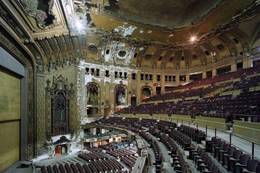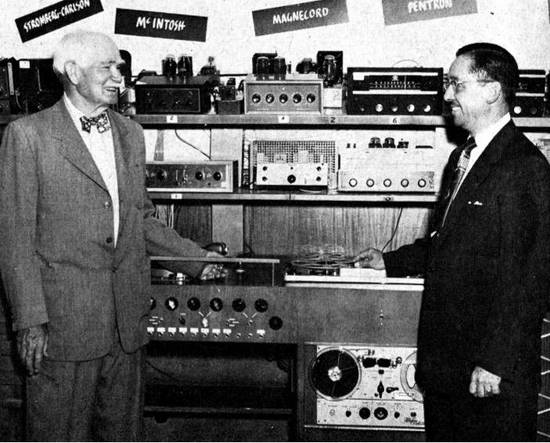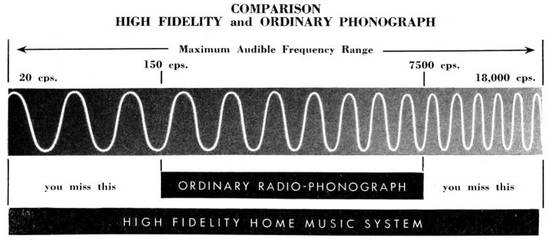Vorwort zu "WHAT IS HIGH FIDELITY ?" aus den USA 1953
Dieser Artikel aus der IST vom September 1953 ist mehr eine Rückschau und eine Auflistung der damals modernsten Entwicklungen auch und vor allem im Bereich des Films und der Kinos.
Wie ich bei der Entwicklung der Hhigh-Fidelity hier bei uns in Deutschland bereits erwähnt hatte, war ein klanglicher Genuß bislang nur in den modernsten großen US-Kinos in den Großstädten möglich. Doch derer gab es in den USA weit mehr als bei uns hier in Westdeutschland, außer daß die deutschen Kino-Paläste in unseren Städten im 2. Weltkrieg weitgehend zerstört waren.
Über den Autor Robert J. Callen ist wenig bekannt, über seinen Gesprächsparter Dr. Lee DeForest dafür um so mehr. Auch die Grafik am Ende des Artikels sagt sehr anschaulich, was bislang mit der Schellackplatte machbar war. Mitten drin in dem Artikel ist ein Foto mit Dr. Lee DeForest in einem der frühen Hifi-Studios.
.
WHAT IS HIGH FIDELITY ? - September 1953
By Robert J. Callen
Facsimile reproduction of sound by the recording process has long been the goal of audio engineers and to overcome the limitations, both mechanical and electrical, of recording and reproducing equipment has been their problem.
Many of us in sound engineering have been repeatedly asked the question — What is High Fidelity Sound ? — and in the final analysis the answer to this question is perhaps as controversial and as limited as the varying degrees of individual tastes and aural sensitivities.
Eine frühe Antwort vom "IRE"
The "Institute of Radio Engineers" some years ago suggested the following simple answer to the question :
"High fidelity sound recording and reproduction is the recording and reproducing of sound over a wide frequency range with a minimum of distortion. It is the reproduction of sound as the listener might imagine the original was performed."
Sogar von Stereo ist die Rede
This definition has doubtless caused much discussion among the ranks of Audiophiles. It purposely avoided any mention of faithful reproduction which would imply the positioning of the origin of the sound. This factor is now possible with a true stereophonic sound system.
Stereophonic sound, about which we have been reading and hearing so much lately, has been with us for over twenty years. Only during the last year has it received public acceptance as an integral part of wide screen motion picture presentation. There is no doubt that the positioning and scope of the sound by means of stereophonic reproduction adds immeasurably to the audience entertainment value in the theater.
Cinerama und auch Cinemascpope waren noch ganz neu
Ample proof (reichhaltige Bestätigung) of this statement can be had by watching Cinerama mit 7-Kanal Ton und (4 Kanal Magnetton mit Cinemascope ist gerade im Kommen) and listening first with both ears, then with one ear at a time and finally without sound.
Stereophonic sound is indeed a full fledged partner of wide screen pictures and not just an adjunct to the picture as monaural sound was considered to conventional picture presentation over the past quarter century.
In 1877
In 1877 when Thomas A. Edison listened to a reproduction of his voice reciting "Mary Had a Little Lamb" which he had embossed on a tin foil surface wrapped on a small cylinder, he opened many avenues of present day enterprise.
He, himself, was not aware of the vast possibilities of his invention for he first considered the phonograph as a toy to be played in the nursery (Kinderzimmer). It remained for other inventors to realize the commercial possibilities and to improve the performance of the phonograph.
By the first quarter of the twentieth century the manufacture of phonographs and records had become big business with the Edison Company as one of the four major companies.
By 1924
By 1924 it was estimated that there were more than fifteen million Victrolas (ein Plattenspieler vor Victor Records) in American homes. At that time the Bell Laboratories announced the completion of the first truly engineered "Orthophonic" phonograph.
It consisted chiefly of a well designed leverage system which coupled the phonograph needle to a diaphram. This diaphram was coupled through an air column to a large wooden exponential horn.
When this new Orthophonic phonograph was demonstrated to the Victor Talking Machine Co. board of directors they were pleased with its clarity of tone and increased volume but they had one criticism — "It just didn't sound like a talking machine!"
Als der "Nadelton" im Kino floppte
It seemed inevitable (folgerichtig) that twelve years after Mr. Edison invented the phonograph, his associate, Mr. Dicksen should combine it with the Motion Picture, which Mr. Edison also invented, to produce the first sound motion picture. Difficulties with synchronization and control of sound volume seemed to make this first sound picture commercially impractical.
In 1907 entwickelte Dr. Lee DeForest das Audion
In 1907 Dr. Lee DeForest patented the Audion (eine der ersten Elektronenröhren) which removed the chief barrier to the recording and reproduction of High Fidelity sound.
With the Audion and the vacuum tube which followed it became possible to amplify and control the volume of sound. After five years of failure to interest any commercial enterprise in developing his Audion, Dr. DeForest finally succeeded in convincing Dr. Arnold of the Bell Laboratories of the value of his invention.
1913 bekam die Western Electric Company die Patente
In 1913 he sold the Audion and all rights thereto, to the Western Electric Company. Eleven vears later the Bell Telephone Laboratories produced their first sound motion picture depicting Western Electric manufacturing techniques.
This was shown at a banquet for company executives in January 1924. The later history of sound in motion picture presentation is well known to our readers it having become a commercial reality in 1928 when "Warner Brothers" started the entertainment world with their first sound picture starring the late Al Jolson entitled "The Jazz Singer."
Der "The Jazz Singer." war aber nur der Anfang
By this time the art and science of sound recording and reproduction was well on its way. With the development of recording techniques, first on discs, then the photographic sound track followed by magnetic recording on steel-wire to the present magnetic recording on film coated with a ferrous oxide emulsion, there has been a constant improvement in the various electronic components used including microphones, amplifiers, tuners, loud speakers, disc pickup heads, filters and equalizers.
Adding all these factors together plus the universal stimulation to the appreciation of good music through the impetus of radio, television and musical pictures, it is inevitable that sound hobbyists, known as Audiophiles, should seek and acquire for their personal satisfaction and entertainment, the newest and the best of equipment for High Fidelity reproduction of their favorite music and artists.
Man solle sich über die Freaks nicht lustig machen, man könnte bald selbst "dazu" gehören" !
Thus has come into being the fraternity of Hi-Fi enthusiasts. Don't scoff (sich lustig machen) when you see that gleam in their eyes as they rapturously (hingerissen) listen to their latest acquired recording or proudly display their new loud speaker system with a four way dividing network. You too may be on the verge (an der Grenze) of becoming one yourself — and incidentally — I can think of many worse ways to spend your time and money.
COMPARISON HIGH FIDELITY and ORDINARY PHONOGRAPH
.
Hier eine ganz frühe Darstellung des eingeschränkten Fequenzbereiches der Schellackplatte im Vergleich zu der damals maximal vorstellbaren Qualität. Die Micro-Groove Platten, also die ersten Mono LPs konnten aber weniger als diese Ideal-Qualität.
.
Maximum Audible Frequency Range
.
- Male voice: 100 to 8,300 cycles
- Female voice: 170 to 10,000 cycles
- Bass clarinet: SO to 15,000 cycles
- Castanets: 500 to 15,000 cycles
- Cello: 65 to 15,000 cycles
- Chimes: 523 to 15,000 cycles
- Flute: 261 to 15,000 cycles
- Glockenspiel: 784 to 15,000 cycles
- Gong: 300 to 15,000 cycles
- Oboe: 283 to 15,000 cycles
- Organ: 29 to 15,000 cycles
- Piccolo: 587 to 15,000 cycles
- Snare drum: 80 to 15,000 cycles
- Saxophone: 55 to 15,000 cycles
- Tambourine: 500 to 15,000 cycles
- Triangle: 500 to 15,000 cycles
- Violin: 190 to 15,000 cycles
- Xylophone: 130 to 15,000 cycles
- Clarinet: 146 to 14,500 cycles
- Bassoon: 58 to 14,000 cycles
- Cymbals: 300 to 14,000 cycles
- Viola: 130 to 11,000 cycles
- Celesta: 261 to 10,000 cycles
- Double Bass: 40 to 9,500 cycles
- Trumpet: 164 to 9,500 cycles
- English Horn: 164 to 8,500 cycles
- French Horn: 90 to 8,200 cycles
- Trombone: SO to 8,000 cycles
- Tuba: 41 to 7,500 cycles
- Piano: 30 to 6,500 cycles
- Bass Drum: 52 to 5,500 cycles
- Tympani: 45 to 4,500 cycles
.




